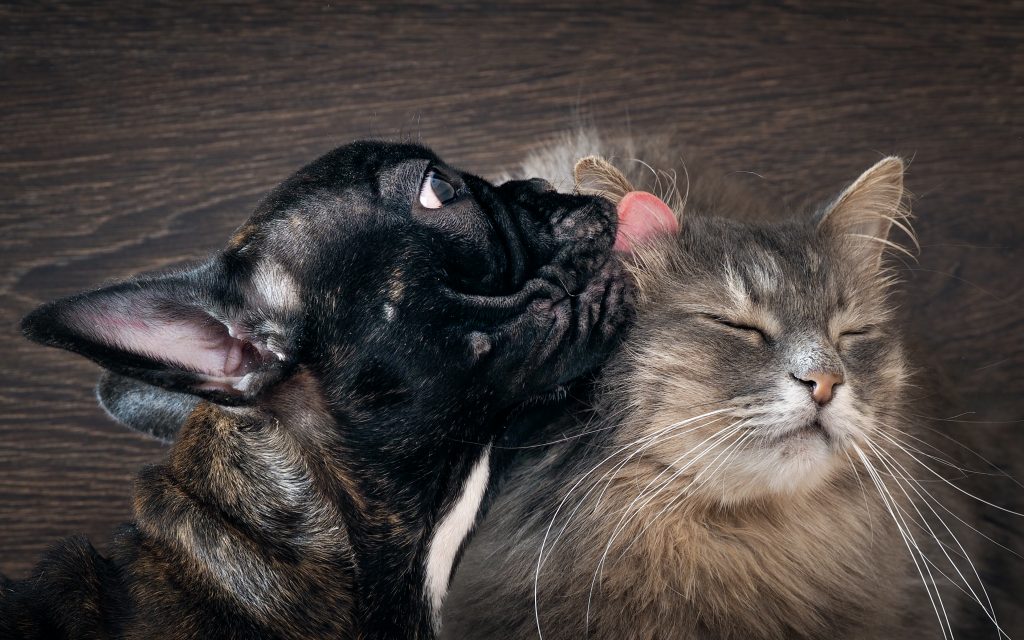Conventional wisdom says that there are “cat people” and “dog people” – but that’s not really true. Sure, some people prefer cats to dogs, and vice versa. But often, both cat and dog people are just animal-loving people. And many of these animal lovers have both cats and dogs (and sometimes birds and turtles and bunnies too.)
The classic trope about cats and dogs not getting along isn’t entirely fiction. Some dogs and cats do not get along. Many dogs have strong prey drives. Many were bred to be hunters. To these dog breeds, cats look a lot like prey. And while cats are often framed as the victim in this sometimes-contentious relationship, they are equally responsible for some of the animosity.
Cats are generally not playful. They are very careful, and get annoyed by dogs. Some cats seem to even look down on dogs. Dogs, however, are usually larger than cats, and can pose more danger. If you plan on getting both a dog and a cat, the following breeds are traditionally good with cats, and should get along fine with them. Your dog and cat may even form an unbreakable bond.
Golden Retriever

The Golden Retriever is high up on just about every dog breed list, mostly because of their sweet disposition. Golden Retrievers do not have a strong prey drive. When they see a cat, curiosity is their reaction, followed by an attempt to befriend them. Goldens only want to love and be loved by everyone – including cats.
Labrador Retrievers
Labs – the most popular dog in the United States according to the AKC ranking – have very similar personalities to Golden Retrievers. They are friendly and passive, which works well with a cat’s more suspicious attitude. Labrador Retrievers can be rambunctious, but one cat claw to the nose and they’ll learn that the family cat might not be the best play toy.
Newfoundland
These gentle giants are friendly with all living beings, including cats. They are more interested in pleasing their owners than chasing a cat. Their size, though it looks intimidating, allows them to view cats as a potential friend rather than a potential threat. Newfoundlands will usually ignore cats – sometimes to the dismay of a cat who is used to being noticed.
Papillion
Nicknamed the “butterfly dog” because it’s large ears are reminiscent of a butterfly’s wings, the Papillion poses no threat to cats, because they are often smaller than cats. The Papillion was bred to be a noblewoman’s lap dog, and has no designs on hunting prey. Your cat will likely be curious about the small creature that has entered his home.
Pug

About the same size as the average cat, the Pug is an excitable little ball of energy that may annoy your cat, but poses no threat to him. Even if a Pug wanted to attack the cat, his squished-in snout and stubby paws make him a terrible hunter.
Maltese
The Maltese’s temperament makes an excellent pet for families with various species of animals in the home. They are friendly and easygoing with a very gentle nature. They are more likely to be bullied by a cat than the other way around. The Maltese is interested in making new friends, not new enemies.
Boston Terrier
The Boston Terrier is concerned with two things – pleasing his owner and having fun. The thought of being aggressive towards the family cat never crosses the Boston Terrier’s mind. He is so friendly that your cat may be a little off-put by his care-free attitude. Your cat may not love the Boston Terrier, but your Boston Terrier will love him.
Yorkshire Terrier
The Yorkie and the cat have a lot in common. They both have four legs, fur and a confident attitude that borders on cockiness. The Yorkshire Terrier is small, so he poses no danger to the cat.
Dachshund
The Dachshund – sometimes called the “hot dog” – is about the same size as a cat, but far less dexterous. Your cat will never feel threatened by this little curiosity with short and stubby legs. In fact, your cat will more likely be amused.
Puppies!
The best way to ensure a happy multi-pet household is to have them grow up together. Puppies of any breed are playful and curious. And they’re small enough to not pose a threat to your cat. In fact, the cat may help you train the puppy by teaching him what is acceptable play and what is not.




